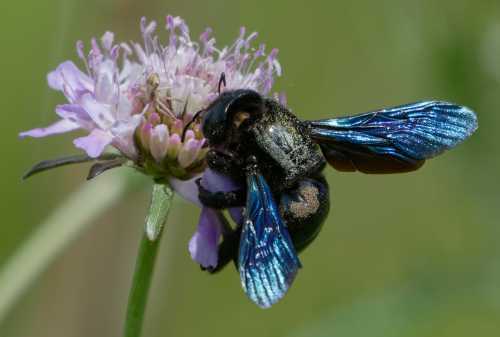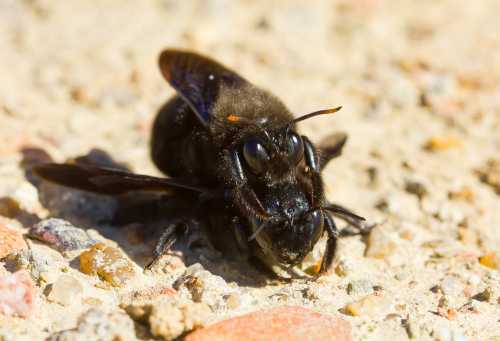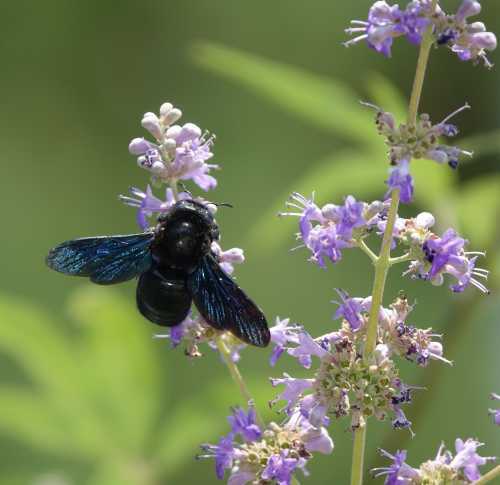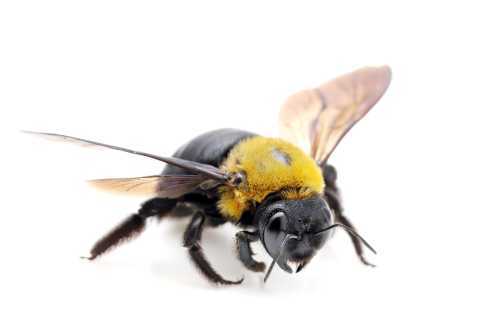The Violet Carpenter Bee - Xylocopa violacea
The Violet Carpenter Bee - Xylocopa violacea is a beautiful,
large black, shiny bee, with an iridescent blue/violet sheen to the wings. It is a member of the Apidae bee family (along with honey bees and bumble bees).
Distribution, Identification And Life Cycle of Life Cycle Of The Violet Carpenter Bee - Xylocopa violacea
This species is primarily found around the Mediterranean Sea and the Black Sea, but increasingly has extended its range into northern Europe, including Poland, Belgium and Germany, with a few isolated recordings in Sweden, one female in Finland, and several recorded in Britain (probably introduced via importation of wood or plant products, rather than natural migration)1.
 Violet carpenter bee Xylocopa violacea
Violet carpenter bee Xylocopa violacea Violet carpenter bees are very similar to another species, also present in Europe - Xylocopa valga - the splay-footed carpenter.
When comparing females, a microscope would be needed to tell them apart, but the difference in males is easily visible by taking a look at the antennae. If a slight reddish tinge is visible at the tip of the antennae, it's a male violet carpenter bee.
In the photograph below of a pair of violet carpenter bees mating, note the reddish tinge to the tips of the antennae of the male, who also happens to be grasping the antennae of the female.
 Violet carpenter bees Xylocopa violacea mating
Violet carpenter bees Xylocopa violacea mating
Below is a lovely short video of a violet carpenter bee busily foraging on flowers. Note the distinctive flight and beautiful wings.
Life Cycle
In southern Italy, the reproductive period starts in late January to early February, and the mating period lasts until late April2 during which time there is tremendous competition between males to mate with females, with males sometimes attempting to disrupt couples in flight3.
Females search for suitable nest sites until June2.
Even in cooler climates, females may emerge relatively early. In the UK females have been observed to forage on a comparitively warm, late February day in England4.
Xylocopa violacea is univoltine (having one generation and one flight period per year) and as with other Xylocopa species, female average fecundity is very low with only 7 - 8 eggs per nest5.
Nesting habits
The name ‘Xylocopa’ is derived from the Greek, and means ‘woodworker’7, in reference to the nest habits of this species.
This bee is arguably a woodworker in two main
ways: firstly, it excavates holes and tunnels (which may feature branches) in rotten
wood and tree branches in which it nests.
Secondly, it fashions nest cell partitions inside the tunnels, from the chewed wood fragments. These partitions measure about 2mm think in middle, but are about twice as thick around the edge4. The length of each individual larval cell has been found to measure from 14 to 20 mm4.
However, in some dry regions, plant stalks such as those of the yucca plants and palms, may also be used for nests1 as well as bamboo canes5.
An author of a number of studies into this species, (Vicidomini2) records a range of different nest defense behaviours.
The foundress female may give out intermittent to continuous buzzing sounds from inside the nest to drive off other intruder females, but will also rush forward to attack in the event the intruder perches by the nest entrance. This is usually sufficient to send the visitor on its way.
Persistent males may additionally engage in a spiraling attack flight. Larger intruders (such as humans) might witness the female flying around them, but at a distance.
Foraging habits of the violet carpenter bee

The violet carpenter bee is a polylectic (selecting pollens from plants of a variety of plant genera and families) and has been observed to visit Nasturtiums1, Wisteria, Lavender, Sweetpea, Runner bean6, Broadbean, Scorpion senna, and peach blossom among others3.
As with other carpenter bees species, violet carpenter bees are known to buzz pollinate.
As a member of the Apidae family, this bee falls into the short-tongued category.
References
- BANASZAK, JÓZEF; CIBICKA, WERONIKA BANASZAK; and TWERD, LUCYNA (2019) "Possible expansion of the range of Xylocopa violacea L. (Hymenoptera, Apiformes, Apidae) in Europe," Turkish Journal of Zoology: Vol. 43: No. 6, Article 14. https://doi.org/10.3906/zoo-1812-6.
- S Vicidomini, Biology of Xylocopa (Xylocopa) violacea (L., 1758)(Hymenoptera: Apidae): female nest-defence. Annali del Museo Civico di Rovereto 12, 85-100, 1998.
- S Vicidomini Biology of Xylocopa (Xylocopa) violacea (Linnaeus, 1758)(Insecta, Hymenoptera, Apidae): male sexual behaviours. II. Atti Mus. civ. Stor. nat. Morbegno 8, 95-113, 1997.
- BWARS - Xylocopa in Britain.
- Salvatore Vicidomini (1996) Biology of Xylocopa violacea (Hymenoptera): In‐nest ethology, Italian Journal of Zoology, 63:3, 237-242, DOI: 10.1080/11250009609356139
- Steven Falk - Field Guide To Bees Of Great Britain And Ireland.
- Wilson & Messenger Carrill - The Bees In Your Backyard.
